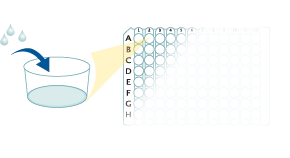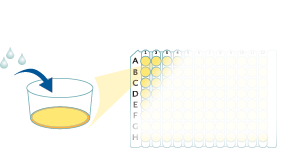Human Nectin-4 Quantikine ELISA Kit Summary
Product Summary
Precision
Cell Culture Supernates, Cell Lysates, Urine
| Intra-Assay Precision | Inter-Assay Precision | |||||
|---|---|---|---|---|---|---|
| Sample | 1 | 2 | 3 | 1 | 2 | 3 |
| n | 20 | 20 | 20 | 20 | 20 | 20 |
| Mean (pg/mL) | 163 | 425 | 1365 | 194 | 474 | 1440 |
| Standard Deviation | 5.56 | 13.9 | 32.7 | 15.8 | 27.9 | 65.8 |
| CV% | 3.4 | 3.3 | 2.4 | 8.1 | 5.9 | 4.6 |
Serum, EDTA Plasma, Heparin Plasma
| Intra-Assay Precision | Inter-Assay Precision | |||||
|---|---|---|---|---|---|---|
| Sample | 1 | 2 | 3 | 1 | 2 | 3 |
| n | 20 | 20 | 20 | 20 | 20 | 20 |
| Mean (pg/mL) | 232 | 603 | 1867 | 245 | 595 | 1801 |
| Standard Deviation | 7.19 | 37.7 | 40.1 | 18.9 | 31.9 | 82.3 |
| CV% | 3.1 | 6.3 | 2.1 | 7.7 | 5.4 | 4.6 |
Recovery
The recovery of human Nectin-4 spiked to levels throughout the range of the assay in various matrices was evaluated.
| Sample Type | Average % Recovery | Range % |
|---|---|---|
| Cell Culture Media (n=4) | 100 | 94-110 |
| EDTA Plasma (n=4) | 89 | 80-109 |
| Heparin Plasma (n=4) | 91 | 82-99 |
| Serum (n=4) | 90 | 80-101 |
| Urine (n=4) | 100 | 93-108 |
Linearity
Scientific Data
Product Datasheets
Preparation and Storage
Background: Nectin-4
Nectins are type I transmembrane glycoproteins that are calcium-independent immunoglobulin (Ig)-like cell adhesion molecules (CAMs). Homology has led to their designation as poliovirus receptor-related (PRR) proteins, but nectins do not bind poliovirus. The extracellular domains of the nectin family form cis-homodimers (same cell), followed by homophilic or heterophilic trans-dimers (across cells) that organize intercellular junctions. Nectin-1, also known as CD111, PRR1 and herpes virus entry mediator C (HVEC) has a secreted splice variant. Nectin-1, Nectin-2 (CD112, PRR2, HVEB) and Nectin-3 (PRR3) are concentrated in adherens junctions and exist on neurons, endothelial cells, epithelial cells and fibroblasts.
Nectin-4 is a type I transmembrane glycoprotein belonging to the Nectin family of Ig superfamily proteins. It is both a homophilic and heterophilic (with Nectin-1) cell adhesion molecule that is expressed in the placenta, the embryo, and in breast carcinoma. A soluble form of Nectin-4 is generated from the membrane protein via the action of TACE/ADAM-17.
Assay Procedure
Refer to the product- Prepare all reagents, standard dilutions, and samples as directed in the product insert.
- Remove excess microplate strips from the plate frame, return them to the foil pouch containing the desiccant pack, and reseal.
- Add 50 µL of Assay Diluent to each well.
- Add 50 µL of Standard, control, or sample to each well. Cover with a plate sealer, and incubate at 2-8 °C for 2 hours.
- Aspirate each well and wash, repeating the process 3 times for a total of 4 washes.
- Add 200 µL of cold Conjugate to each well. Cover with a new plate sealer, and incubate at 2-8 °C for 2 hours.
- Aspirate and wash 4 times.
- Add 200 µL Substrate Solution to each well. Incubate at room temperature for 30 minutes. PROTECT FROM LIGHT.
- Add 50 µL of Stop Solution to each well. Read at 450 nm within 30 minutes. Set wavelength correction to 540 nm or 570 nm.





Citations for Human Nectin-4 Quantikine ELISA Kit
R&D Systems personnel manually curate a database that contains references using R&D Systems products. The data collected includes not only links to publications in PubMed, but also provides information about sample types, species, and experimental conditions.
2
Citations: Showing 1 - 2
Filter your results:
Filter by:
-
Genetic variants in NECTIN4 encoding an adhesion molecule are associated with continued opioid use
Authors: CP Fang, TH Liu, RH Chung, HH Tsou, HW Kuo, SC Wang, CC Liu, SC Liu, ACH Chen, YL Liu
PLoS ONE, 2020-06-18;15(6):e0234549.
Species: Human
Sample Types: Plasma
-
Ectodomain Shedding of the Cell Adhesion Molecule Nectin-4 in Ovarian Cancer is Mediated by ADAM10 and ADAM17
Authors: PC Buchanan, KL Boylan, B Walcheck, R Heinze, MA Geller, PA Argenta, AP Skubitz
J. Biol. Chem, 2017-02-23;0(0):.
Species: Human
Sample Types: Serum
FAQs
-
Does Human Nectin-4 Quantikine ELISA kit detect the soluble and/or total protein?
This kit detects both soluble and transmembrane Nectin-4, confirmed by sample measurements in cell culture supernatants and the corresponding cell lysates.
Reviews for Human Nectin-4 Quantikine ELISA Kit
There are currently no reviews for this product. Be the first to review Human Nectin-4 Quantikine ELISA Kit and earn rewards!
Have you used Human Nectin-4 Quantikine ELISA Kit?
Submit a review and receive an Amazon gift card.
$25/€18/£15/$25CAN/¥75 Yuan/¥2500 Yen for a review with an image
$10/€7/£6/$10 CAD/¥70 Yuan/¥1110 Yen for a review without an image





